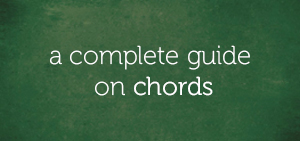If you desire to go beyond triads and start incorporating seventh chords into your playing, the part-over-root voicing is certainly a voicing technique to consider.
A voicing is the consideration of the notes of a chord as voice parts. With this approach, the notes are rearranged in a certain manner. “Part-over-root” (POR) is just one of the several voicing techniques (aka – “rearrangements”) available to you.
Seventh chords are four-note chords. Here’s the classic Cmaj7 chord:
There are people out there who find it challenging to play these four-note chords. However, with this voicing technique, chord tones can be rearranged in such a way that you can have triads on the right hand and still achieve an overall seventh chord.
Seventh Chords
Seventh chords are basically chords that encompass seven degrees of the major scale.
Using the C major scale above as a reference, the seventh tone is B:
Using my pick and skip principle, you can form triads and seventh chords on any key of the scale.
Starting from C:
…skip D, pick E:
…skip F, pick G:
…skip A, and pick B:
…which is the seventh degree.
So put together, C, E, G, and B combine together to create a C major seventh – encompassing seven degrees of the major scale.
The major seventh chord is just one out of the several types of seventh chords.
“What is a Part-Over-Root Voicing Though?”
Like I said earlier, a voicing is the consideration of the notes of a chord as voice parts, and also re-arranging them to move to the closest possible notes (voice leading) when played in chord progressions.
Part-over-root voicings become very important when you want to achieve more with less.
Consider this carefully…
The part-over-root voicing is a technique that breaks up a chord into two parts. The root is isolated from the other chord tones and whatever is left is considered a part.
Using the C major seventh chord…
Isolation of the root (C) from the chord and transposing it an octave below its position will produce:
…the part-over-root voicing of C major seventh.
Even though the remaining chord tones (part) is recognizably an E min triad:
…however, with the C note on the bass:
…this will produce a C major seventh, overall.
Let’s consider the part-over-root voicing of five common seventh chord types.
Chord Type #1 – Major Seventh
C major seventh chord:
…can be played in such a way that the root is isolated from other chord tones:
When the root is isolated, the chord tones that are left are known as the part. In the case of C major seventh:
…isolating C (and transposing it an octave lower):
…will leave us with an an E minor part:
This is the part-over-root voicing of C major seventh:
Chord Type #2 – Minor Seventh
C minor seventh chord:
…can be played in such a way that the root is isolated from other chord tones:
When the root is isolated, the chord tones that are left are known as the part. In this case, isolating C:
…will leave us with an Eb major part:
This is the part-over-root voicing of C minor seventh:
Chord Type #3 – Dominant Seventh
C dominant seventh chord:
…can be played in such a way that the root is isolated from other chord tones:
When the root is isolated, the chord tones that are left are known as the part. In this case, isolating C:
…will leave us with an E diminished part:
This is the part-over-root voicing of C dominant seventh:
Chord Type #4 – Half-Diminished Seventh
C half-diminished seventh chord:
…can be played in such a way that the root is isolated from other chord tones:
When the root is isolated, the chord tones that are left are known as the part. In this case, isolating C:
…will leave us with an Eb minor part:
This is the part-over-root voicing of C half-diminished seventh:
Chord Type #5 – Diminished Seventh
C diminished seventh chord:
…can be played in such a way that the root is isolated from other chord tones:
When the root is isolated, the chord tones that are left are known as the part. In this case, isolating C:
…will leave us with an Eb diminished part:
This is the part-over-root voicing of C diminished seventh:
Putting It Together
Here are the part-over-root voicings of the seventh chords we’ve covered in this lesson:
E minor / C (aka – “C major seventh”):
After isolating the root, the remaining chord tones (part) of the major seventh chord is a minor triad.
Eb major / C (aka – “C minor seventh”):
After isolating the root, the remaining chord tones (part) of the minor seventh chord is a major triad.
E diminished / C (aka – “C dominant seventh”):
After isolating the root, the remaining chord tones (part) of the dominant seventh chord is a diminished triad.
Eb minor / C (aka – “C half-diminished seventh”):
After isolating the root, the remaining chord tones (part) of the half-diminished seventh chord is a minor triad.
Eb diminished / C (aka – “C diminished seventh”):
After isolating the root, the remaining chord tones (part) of the diminished seventh chord is a diminished triad.
Check out how it looks in tabular form below:
|
Seventh Chord |
Part Over Root |
|
Major seventh |
E minor / C |
|
Minor seventh |
Eb major / C |
|
Dominant seventh |
E diminished / C |
|
Half-diminished seventh |
Eb minor / C |
|
Diminished seventh |
Eb diminished / C |
In Jazz and other popular music styles, seventh chords are often times written as part-over-root. For example, F major / D…
…is the part-over-root voicing of the D minor seventh chord.
Final Words
Part-over-root voicings of seventh chords use triads on the right hand over a bass note on the left.
75% of the classes of triads we covered in our 16-week chord revival program are used here – major, minor and diminished triads. This means that knowledge of all triad qualities in all 12 keys is important.
I hope to take you to the next level in another post where I’ll be showing you the secrets to the formation of various qualities of seventh chords in all keys.
Bye for now.
P.S.
If you haven’t joined our 16-week chord revival program, click here to check it out.
Chuku Onyemachi
Latest posts by Chuku Onyemachi (see all)
- The Formation Of Diminished Seventh Chords Used To Be Challenging Until I Did This
- How To Form Seventh Chords In Two Shakes Of A Dog’s Tail Using Third Intervals And The Circle Of Fifths Chart
- I Played The 13sus4 Chord And This Happened…
- How To Build Seventh Chords Like An Architect Using “Foundation And Structure” Concept
- This 4-Week Plan Will Help You Master All The Major Scales







Comments on this entry are closed.